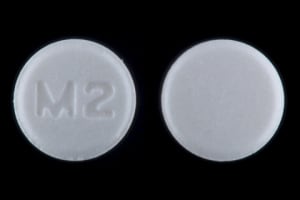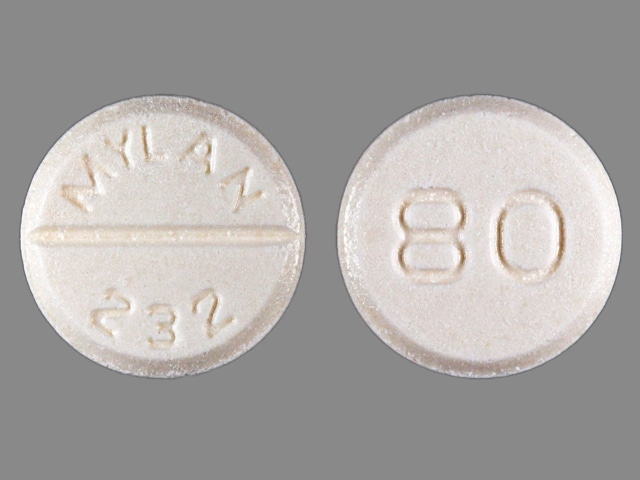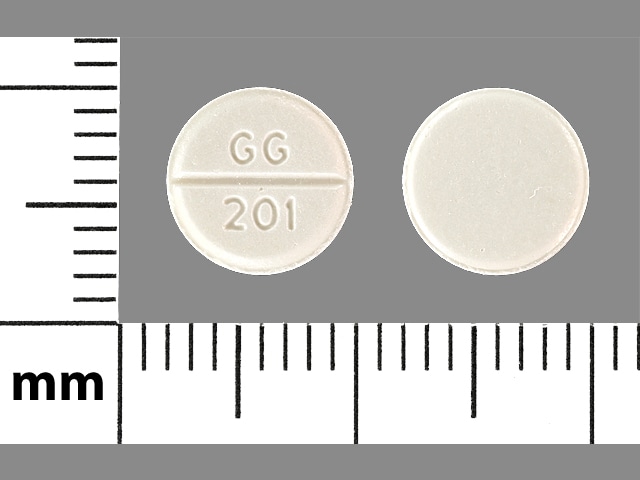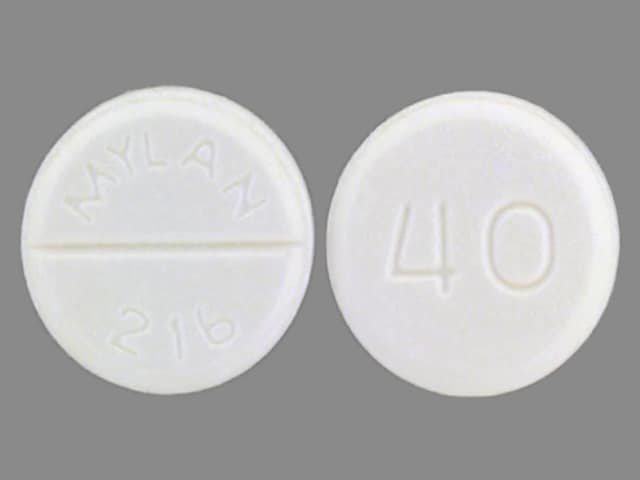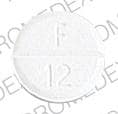Boxed Warning
Fluid/electrolyte loss:
Furosemide is a potent diuretic that, if given in excessive amounts, can lead to a profound diuresis with water and electrolyte depletion. Therefore, careful medical supervision is required and dose and dose schedule must be adjusted to the individual patient's needs.
Dosage Forms
Excipient information presented when available (limited, particularly for generics); consult specific product labeling.
Solution, Injection:
Generic: 10 mg/mL (2 mL, 4 mL, 10 mL)
Solution, Injection [preservative free]:
Generic: 10 mg/mL (2 mL, 4 mL, 10 mL)
Solution, Oral:
Generic: 8 mg/mL (500 mL); 10 mg/mL (60 mL, 120 mL)
Tablet, Oral:
Lasix: 20 mg
Lasix: 40 mg, 80 mg [scored]
Generic: 20 mg, 40 mg, 80 mg
Pharmacology
Mechanism of Action
Primarily inhibits reabsorption of sodium and chloride in the ascending loop of Henle and proximal and distal renal tubules, interfering with the chloride-binding cotransport system, thus causing its natriuretic effect (Rose 1991).
Pharmacokinetics/Pharmacodynamics
Metabolism
Minimally hepatic
Excretion
Urine (Oral: 50%, IV: 80%) within 24 hours; feces (as unchanged drug); nonrenal clearance prolonged with renal impairment
Onset of Action
Diuresis: Oral, sublingual: 30 to 60 minutes.
Symptomatic improvement with acute pulmonary edema: Within 15 to 20 minutes; occurs prior to diuretic effect.
Peak effect: Oral, SL: 1 to 2 hours; IV: 0.5 hours.
Duration of Action
Oral, sublingual: 6 to 8 hours; IV: 2 hours
Half-Life Elimination
Normal renal function: 0.5 to 2 hours; End-stage renal disease (ESRD): 9 hours
Protein Binding
91% to 99%; primarily to albumin
Use: Labeled Indications
Edema: Management of edema associated with heart failure, cirrhosis of the liver (ie, ascites), or renal disease (including nephrotic syndrome); acute pulmonary edema.
Contraindications
Hypersensitivity to furosemide or any component of the formulation; anuria
Canadian labeling: Additional contraindications (not in US labeling): Hypersensitivity to sulfonamide-derived drugs; complete renal shutdown; hepatic coma and precoma; uncorrected states of electrolyte depletion, hypovolemia, dehydration, or hypotension; jaundiced newborn infants or infants with disease(s) capable of causing hyperbilirubinemia and possibly kernicterus; breast-feeding. Note: Manufacturer labeling for Lasix Special and Furosemide Special Injection also includes: GFR <5 mL/minute or GFR >20 mL/minute; hepatic cirrhosis; renal failure accompanied by hepatic coma and precoma; renal failure due to poisoning with nephrotoxic or hepatotoxic substances.
Note: Although the approved product labeling states this medication is contraindicated with other sulfonamide-containing drug classes, the scientific basis of this statement has been challenged. See “Warnings/Precautions” for more detail.
Dosage and Administration
Dosing: Adult
Note: Loop diuretic approximate oral dose equivalency for patients with normal renal function: furosemide 40 mg = bumetanide 1 mg = torsemide 20 mg (ACCF/AHA [Yancy 2013]; Brater 2019a; Brater 1983; Felker 2011). Some experts suggest an approximate oral dose equivalency of furosemide 40 mg = bumetanide 1 mg = torsemide 10 mg (Felker 2012; Vargo 1995).
Ascites, due to cirrhosis:
Note: Generally used in combination with spironolactone but may be used as monotherapy for patients with hyperkalemia. For combination therapy, a dosing ratio of spironolactone 100 mg to furosemide 40 mg should generally be maintained but can be adjusted for electrolyte abnormalities (AASLD [Runyon 2013]; Runyon 2019).
Oral: Initial: 40 mg once daily; titrate every 3 to 5 days based on response and tolerability; once-daily dosing is preferred; maximum dose: 160 mg once daily (AASLD [Runyon 2013]; Runyon 2019). For small-volume ascites in patients who weigh <50 kg, some experts recommend a starting dose of 20 mg once daily (Runyon 2019).
Edema (eg, peripheral, pulmonary, generalized):
Naive to loop diuretics:
Oral, IV: Initial: 20 to 40 mg once then titrate as needed to an effective dose (see Titration to effect below) (Brater 2011; Sterns 2019).
Note: Oral bioavailability varies widely but on average is 50% of the IV dose (Brater 2011).
Refractory edema or acute decompensation in patients taking oral loop diuretics: IV:
Bolus/intermittent dosing: Initial: Administer 1 to 2.5 times the total daily oral maintenance dose once (eg, a patient taking oral furosemide 40 mg twice daily at home [80 mg/day] can be given 80 mg to 200 mg IV as an initial bolus) then titrate as needed to an effective dose (see Titration to effect below) (ACC [Hollenberg 2019]; Brater 2011; Brater 2019b; Colucci 2019; Felker 2011).
Continuous infusion: Note: Reserve for patients who have responded to bolus therapy.
Estimated GFR ≥30 mL/minute/1.73 m2: IV: Initial: 5 mg/hour; if diuretic response is not adequate, repeat IV bolus dose and increase continuous infusion to 10 mg/hour; continue to bolus and titrate infusion as needed up to 40 mg/hour (Brater 2011; Brater 2019b).
Estimated GFR <30 mL/minute/1.73 m2: IV: Initial: 20 mg/hour; if diuretic response is not adequate, repeat IV bolus dose and increase continuous infusion to 40 mg/hour (Brater 2011; Brater 2019b).
Note: Higher continuous infusion rates have been described but are not recommended due to potential for side effects; consider alternative strategies for fluid removal (Brater 2019b).
Titration to effect: If the initial dose does not result in diuresis, double the individual dose (rather than administer the same dose more frequently) until diuresis occurs. Titration of an IV dose can occur at ≥2-hour intervals as needed in hospitalized patients. Once an effective dose is identified, it is typically administered once or twice daily but may be given more frequently if needed. The maximum effective dose varies by population; higher-than-usual doses may be required for patients with nephrotic syndrome or renal failure. The maximum recommended total daily dose is 600 mg/day to avoid toxicity (Brater 2011; Brater 2019a; Brater 2019b; ACC [Hollenberg 2019]).
Transitioning from IV to oral: There is substantial variability in oral bioavailability; some experts recommend giving 1 to 2 times the IV dose orally (eg, total daily IV dose of 80 mg/day should be converted to an oral dose of 80 to 160 mg/day in 1 to 2 divided doses), then monitoring urine output and adjusting oral dose as needed (Brater 2011; Brater 2019b; Kaojarern 1982; Murray 1997; Vargo 1995).
Dosing: Geriatric
Oral, IV: Initial: 20 mg/day; increase slowly to desired response.
Dosing: Pediatric
Note: Oral and parenteral (IV, IM) doses may not be interchangeable; due to differences in bioavailability, oral doses are typically higher than IV. Oral solution is available in multiple concentrations (8 mg/mL and 10 mg/mL); extra precautions should be taken to verify and avoid confusion between the different concentrations; dose should be clearly presented as mg (not mL). Oral dose equivalency for adult patients with normal renal function (approximate): Furosemide 40 mg = bumetanide 1 mg = torsemide 20 mg = ethacrynic acid 50 mg (Brater 1983; Cody 1994; Vargo 1995).
Edema (diuresis):
Oral: Infants, Children, and Adolescents:
Intermittent dosing (acute): Initial: 2 mg/kg as a single dose; if ineffective, may increase in 6 to 8 hours in increments of 1 to 2 mg/kg/dose; maximum dose: 6 mg/kg/dose.
Maintenance dosing (chronic): Limited data available: Initial: 0.5 to 2 mg/kg/dose every 6 to 24 hours; usual initial adult dose: 20 to 80 mg/dose; if initial dose ineffective, may increase dose in increments of 1 to 2 mg/kg/dose; maximum daily dose: 6 mg/kg/day not to exceed maximum adult daily dose: 600 mg/day; adjust dose to minimal effective dose for maintenance (Flynn 2011; Kliegman 2016; NHBPEP 2004; van der Vorst 2006). Note: Smaller doses on a mg/kg basis may be needed in larger children, especially in those who are diuretic naive.
IM, intermittent IV: Infants, Children, and Adolescents: Limited data available: Initial: 0.5 to 2 mg/kg/dose every 6 to 12 hours; usual initial adult dose: 20 to 40 mg/dose; if initial dose ineffective after 2 hours, may increase dose by 1 mg/kg/dose; maximum dose: 6 mg/kg/dose not to exceed maximum adult dose: 200 mg/dose; adjust to minimal effective dose for maintenance (Brater 1998; Fuhrman 2017; Kliegman 2016; van der Vorst 2006; Wells 1990). Note: Smaller doses on a mg/kg basis may be needed in larger children, especially in those who are diuretic naive. Dosing in adolescents based on experience in adult and pediatric patients.
Continuous IV infusion:
Infants and Children: Limited data available: Initial: IV bolus dose of 0.1 mg/kg followed by continuous IV infusion of 0.05 to 0.4 mg/kg/hour; titrate dosage to clinical effect (Copeland 1983; Luciani 1997; Singh 1992; van der Vorst 2001).
Adolescents: Very limited data available; dosing in adolescents based on reported experience in adult and pediatric patients (ACCF/AHA [Yancy 2013]); Brater 1998; Copeland 1983; Howard 2001; Luciani 1997; Singh 1992; van der Vorst 2001): IV bolus dose of 0.1 mg/kg; usual adult bolus dose: 40 to 100 mg over 1 to 2 minutes; followed by continuous IV infusion of 0.1 to 0.4 mg/kg/hour; usual adult dosing range: 10 to 40 mg/hour.
Reconstitution
IV infusion solution may be mixed in NS or D5W solution. May also be diluted for infusion to 1 to 2 mg/mL (maximum: 10 mg/mL).
Administration
Parenteral: Undiluted direct IV injections may be administered at a rate of 20 to 40 mg per minute; high doses (eg, ≥160 mg) should be given as a short-term infusion at a maximum rate of administration of 4 mg/minute; exceeding this rate increases the risk of ototoxicity (Brater 2019b).
Oral: May administer with or without food.
Note: When IV or oral administration is not possible, the sublingual route may be used. Place 1 tablet under tongue for at least 5 minutes to allow for maximal absorption. Patients should be advised not to swallow during disintegration time (Haegeli 2007).
Dietary Considerations
May cause potassium loss; potassium supplement or dietary changes may be required.
Storage
Injection: Store at room temperature. Protect from light. Exposure to light may cause discoloration; do not use furosemide solutions if they have a yellow color. Furosemide solutions are unstable in acidic media, but very stable in basic media. Refrigeration may result in precipitation or crystallization; however, resolubilization at room temperature or warming may be performed without affecting the drug's stability. Infusion solution in D5W, NS, or LR is stable for 24 hours at room temperature.
Tablet, solution: Store at 25°C (77°F); excursions permitted to 15°C to 30°C (59°F to 89°F). Protect from light. Discard opened bottle of solution after 90 days (10 mg/mL concentration only).
Furosemide Images
Drug Interactions
Acebrophylline: May enhance the therapeutic effect of Furosemide. Monitor therapy
Ajmaline: Sulfonamides may enhance the adverse/toxic effect of Ajmaline. Specifically, the risk for cholestasis may be increased. Monitor therapy
Alfuzosin: May enhance the hypotensive effect of Blood Pressure Lowering Agents. Monitor therapy
Aliskiren: May decrease the serum concentration of Furosemide. Monitor therapy
Allopurinol: Loop Diuretics may enhance the adverse/toxic effect of Allopurinol. Loop Diuretics may increase the serum concentration of Allopurinol. Specifically, Loop Diuretics may increase the concentration of Oxypurinol, an active metabolite of Allopurinol. Monitor therapy
Amifostine: Blood Pressure Lowering Agents may enhance the hypotensive effect of Amifostine. Management: When amifostine is used at chemotherapy doses, blood pressure lowering medications should be withheld for 24 hours prior to amifostine administration. If blood pressure lowering therapy cannot be withheld, amifostine should not be administered. Consider therapy modification
Amikacin (Oral Inhalation): Loop Diuretics may enhance the nephrotoxic effect of Amikacin (Oral Inhalation). Loop Diuretics may enhance the ototoxic effect of Amikacin (Oral Inhalation). Monitor therapy
Aminoglycosides: Loop Diuretics may enhance the adverse/toxic effect of Aminoglycosides. Specifically, nephrotoxicity and ototoxicity. Monitor therapy
Amphetamines: May diminish the antihypertensive effect of Antihypertensive Agents. Monitor therapy
Angiotensin-Converting Enzyme Inhibitors: Loop Diuretics may enhance the hypotensive effect of Angiotensin-Converting Enzyme Inhibitors. Loop Diuretics may enhance the nephrotoxic effect of Angiotensin-Converting Enzyme Inhibitors. Monitor therapy
Antidiabetic Agents: Hyperglycemia-Associated Agents may diminish the therapeutic effect of Antidiabetic Agents. Monitor therapy
Antipsychotic Agents (Second Generation [Atypical]): Blood Pressure Lowering Agents may enhance the hypotensive effect of Antipsychotic Agents (Second Generation [Atypical]). Monitor therapy
Barbiturates: May enhance the hypotensive effect of Blood Pressure Lowering Agents. Monitor therapy
Benperidol: May enhance the hypotensive effect of Blood Pressure Lowering Agents. Monitor therapy
Beta2-Agonists: May enhance the hypokalemic effect of Loop Diuretics. Monitor therapy
Bilastine: Loop Diuretics may enhance the QTc-prolonging effect of Bilastine. Monitor therapy
Bile Acid Sequestrants: May decrease the absorption of Loop Diuretics. Consider therapy modification
Brigatinib: May diminish the antihypertensive effect of Antihypertensive Agents. Brigatinib may enhance the bradycardic effect of Antihypertensive Agents. Monitor therapy
Brimonidine (Topical): May enhance the hypotensive effect of Blood Pressure Lowering Agents. Monitor therapy
Bromperidol: Blood Pressure Lowering Agents may enhance the hypotensive effect of Bromperidol. Bromperidol may diminish the hypotensive effect of Blood Pressure Lowering Agents. Avoid combination
Cabozantinib: MRP2 Inhibitors may increase the serum concentration of Cabozantinib. Monitor therapy
Canagliflozin: May enhance the hypotensive effect of Loop Diuretics. Management: If canagliflozin is combined with a loop diuretic, monitor for symptoms of intravascular volume depletion and hypotension. Canadian product labeling recommends avoiding the combination of canagliflozin and loop diuretics. Consider therapy modification
Cardiac Glycosides: Loop Diuretics may enhance the adverse/toxic effect of Cardiac Glycosides. Specifically, cardiac glycoside toxicity may be enhanced by the hypokalemic and hypomagnesemic effect of loop diuretics. Monitor therapy
Cefazedone: May enhance the nephrotoxic effect of Loop Diuretics. Monitor therapy
Cefotiam: Loop Diuretics may enhance the nephrotoxic effect of Cefotiam. Monitor therapy
Cefpirome: Loop Diuretics may enhance the nephrotoxic effect of Cefpirome. Monitor therapy
Ceftizoxime: Loop Diuretics may enhance the nephrotoxic effect of Ceftizoxime. Monitor therapy
Cephalothin: Loop Diuretics may enhance the nephrotoxic effect of Cephalothin. Monitor therapy
Cephradine: May enhance the nephrotoxic effect of Loop Diuretics. Monitor therapy
Chloral Betaine: Furosemide may enhance the adverse/toxic effect of Chloral Betaine. Consider therapy modification
Chloral Hydrate: Furosemide may enhance the adverse/toxic effect of Chloral Hydrate. Avoid combination
CISplatin: Loop Diuretics may enhance the nephrotoxic effect of CISplatin. Loop Diuretics may enhance the ototoxic effect of CISplatin. Monitor therapy
Corticosteroids (Orally Inhaled): May enhance the hypokalemic effect of Loop Diuretics. Monitor therapy
Corticosteroids (Systemic): May enhance the hypokalemic effect of Loop Diuretics. Monitor therapy
CycloSPORINE (Systemic): May enhance the adverse/toxic effect of Loop Diuretics. Monitor therapy
Desmopressin: Loop Diuretics may enhance the hyponatremic effect of Desmopressin. Avoid combination
Dexmethylphenidate: May diminish the therapeutic effect of Antihypertensive Agents. Monitor therapy
Diacerein: May enhance the therapeutic effect of Diuretics. Specifically, the risk for dehydration or hypokalemia may be increased. Monitor therapy
Diazoxide: May enhance the hypotensive effect of Blood Pressure Lowering Agents. Monitor therapy
Dichlorphenamide: Loop Diuretics may enhance the hypokalemic effect of Dichlorphenamide. Monitor therapy
Dofetilide: Loop Diuretics may enhance the QTc-prolonging effect of Dofetilide. Management: Monitor serum potassium and magnesium more closely when dofetilide is combined with loop diuretics. Some therapy modification may be required. Consider therapy modification
DULoxetine: Blood Pressure Lowering Agents may enhance the hypotensive effect of DULoxetine. Monitor therapy
Empagliflozin: May enhance the hypotensive effect of Loop Diuretics. Monitor therapy
Ethacrynic Acid: Furosemide may enhance the ototoxic effect of Ethacrynic Acid. Avoid combination
Fexinidazole [INT]: May enhance the arrhythmogenic effect of Loop Diuretics. Avoid combination
Foscarnet: Loop Diuretics may increase the serum concentration of Foscarnet. Consider therapy modification
Fosphenytoin: May diminish the diuretic effect of Loop Diuretics. Monitor therapy
Herbs (Hypertensive Properties): May diminish the antihypertensive effect of Antihypertensive Agents. Monitor therapy
Herbs (Hypotensive Properties): May enhance the hypotensive effect of Blood Pressure Lowering Agents. Monitor therapy
Hypotension-Associated Agents: Blood Pressure Lowering Agents may enhance the hypotensive effect of Hypotension-Associated Agents. Monitor therapy
Ipragliflozin: May enhance the adverse/toxic effect of Loop Diuretics. Specifically, the risk for intravascular volume depletion may be increased. Monitor therapy
Ivabradine: Loop Diuretics may enhance the arrhythmogenic effect of Ivabradine. Monitor therapy
Levodopa-Containing Products: Blood Pressure Lowering Agents may enhance the hypotensive effect of Levodopa-Containing Products. Monitor therapy
Levosulpiride: Loop Diuretics may enhance the adverse/toxic effect of Levosulpiride. Avoid combination
Licorice: May enhance the hypokalemic effect of Loop Diuretics. Monitor therapy
Lithium: Loop Diuretics may decrease the serum concentration of Lithium. Loop Diuretics may increase the serum concentration of Lithium. Monitor therapy
Lormetazepam: May enhance the hypotensive effect of Blood Pressure Lowering Agents. Monitor therapy
Mecamylamine: Sulfonamides may enhance the adverse/toxic effect of Mecamylamine. Avoid combination
Methotrexate: May diminish the therapeutic effect of Loop Diuretics. Loop Diuretics may increase the serum concentration of Methotrexate. Methotrexate may increase the serum concentration of Loop Diuretics. Management: Monitor for increased methotrexate and/or loop diuretic levels/toxicity with concomitant use of these agents and monitor for decreased therapeutic effects of loop diuretics. Methotrexate and/or loop diuretic dose reductions may be necessary. Consider therapy modification
Methylphenidate: May diminish the antihypertensive effect of Antihypertensive Agents. Monitor therapy
Molsidomine: May enhance the hypotensive effect of Blood Pressure Lowering Agents. Monitor therapy
Naftopidil: May enhance the hypotensive effect of Blood Pressure Lowering Agents. Monitor therapy
Neuromuscular-Blocking Agents: Loop Diuretics may diminish the neuromuscular-blocking effect of Neuromuscular-Blocking Agents. Loop Diuretics may enhance the neuromuscular-blocking effect of Neuromuscular-Blocking Agents. Monitor therapy
Nicergoline: May enhance the hypotensive effect of Blood Pressure Lowering Agents. Monitor therapy
Nicorandil: May enhance the hypotensive effect of Blood Pressure Lowering Agents. Monitor therapy
Nitisinone: May increase the serum concentration of OAT1/3 Substrates. Monitor therapy
Nitroprusside: Blood Pressure Lowering Agents may enhance the hypotensive effect of Nitroprusside. Monitor therapy
Nonsteroidal Anti-Inflammatory Agents: May diminish the diuretic effect of Loop Diuretics. Loop Diuretics may enhance the nephrotoxic effect of Nonsteroidal Anti-Inflammatory Agents. Management: Monitor for evidence of kidney injury or decreased therapeutic effects of loop diuretics with concurrent use of an NSAID. Consider avoiding concurrent use in CHF or cirrhosis. Concomitant use of bumetanide with indomethacin is not recommended. Consider therapy modification
Obinutuzumab: May enhance the hypotensive effect of Blood Pressure Lowering Agents. Management: Consider temporarily withholding blood pressure lowering medications beginning 12 hours prior to obinutuzumab infusion and continuing until 1 hour after the end of the infusion. Consider therapy modification
Opioid Agonists: May enhance the adverse/toxic effect of Diuretics. Opioid Agonists may diminish the therapeutic effect of Diuretics. Monitor therapy
Pentoxifylline: May enhance the hypotensive effect of Blood Pressure Lowering Agents. Monitor therapy
Phenytoin: May diminish the diuretic effect of Loop Diuretics. Monitor therapy
Pholcodine: Blood Pressure Lowering Agents may enhance the hypotensive effect of Pholcodine. Monitor therapy
Phosphodiesterase 5 Inhibitors: May enhance the hypotensive effect of Blood Pressure Lowering Agents. Monitor therapy
Pretomanid: May increase the serum concentration of OAT1/3 Substrates. Monitor therapy
Probenecid: May enhance the adverse/toxic effect of Loop Diuretics. Probenecid may diminish the diuretic effect of Loop Diuretics. Probenecid may increase the serum concentration of Loop Diuretics. Management: Monitor for decreased diuretic effects or increased adverse effects of loop diuretics with concomitant use of probenecid. Bumetanide prescribing information recommends against concomitant use of probenecid. Monitor therapy
Promazine: Loop Diuretics may enhance the QTc-prolonging effect of Promazine. Avoid combination
Prostacyclin Analogues: May enhance the hypotensive effect of Blood Pressure Lowering Agents. Monitor therapy
Quinagolide: May enhance the hypotensive effect of Blood Pressure Lowering Agents. Monitor therapy
Reboxetine: May enhance the hypokalemic effect of Loop Diuretics. Monitor therapy
RisperiDONE: Loop Diuretics may enhance the adverse/toxic effect of RisperiDONE. Monitor therapy
Salicylates: May diminish the diuretic effect of Loop Diuretics. Loop Diuretics may increase the serum concentration of Salicylates. Monitor therapy
Sodium Phosphates: Diuretics may enhance the nephrotoxic effect of Sodium Phosphates. Specifically, the risk of acute phosphate nephropathy may be enhanced. Management: Consider avoiding this combination by temporarily suspending treatment with diuretics, or seeking alternatives to oral sodium phosphate bowel preparation. If the combination cannot be avoided, hydrate adequately and monitor fluid and renal status. Consider therapy modification
Sucralfate: May decrease the serum concentration of Furosemide. Sucralfate may impair the absorption of furosemide. Management: Avoid concomitant oral administration of furosemide and sucralfate. Separate administration by at least 2 hours. Does not apply to parenterally administered furosemide. Consider therapy modification
Teriflunomide: May increase the serum concentration of OAT1/3 Substrates. Monitor therapy
Tobramycin (Oral Inhalation): Loop Diuretics may enhance the nephrotoxic effect of Tobramycin (Oral Inhalation). Loop Diuretics may enhance the ototoxic effect of Tobramycin (Oral Inhalation). Monitor therapy
Tolvaptan: May increase the serum concentration of OAT1/3 Substrates. Management: Patients being treated with the Jynarque brand of tolvaptan should avoid concomitant use of OAT1/3 substrates. Concentrations and effects of the OAT1/3 substrate would be expected to increase with any combined use. Consider therapy modification
Topiramate: Loop Diuretics may enhance the hypokalemic effect of Topiramate. Monitor therapy
Xipamide: May enhance the adverse/toxic effect of Loop Diuretics. Specifically, the risk of hypovolemia, electrolyte disturbances, and prerenal azotemia may be increased. Monitor therapy
Yohimbine: May diminish the antihypertensive effect of Antihypertensive Agents. Monitor therapy
Test Interactions
May lead to false-negative aldosterone/renin ratio (ARR) (Funder 2016).
Adverse Reactions
Frequency not defined:
Cardiovascular: Necrotizing angiitis, orthostatic hypotension, thrombophlebitis, vasculitis
Central nervous system: Dizziness, headache, paresthesia, restlessness, vertigo
Dermatologic: Acute generalized exanthematous pustulosis, bullous pemphigoid, erythema multiforme, exfoliative dermatitis, pruritus, skin photosensitivity, skin rash, Stevens-Johnson syndrome, toxic epidermal necrolysis, urticaria
Endocrine & metabolic: Glycosuria, hyperglycemia, hyperuricemia, increased serum cholesterol, increased serum triglycerides
Gastrointestinal: Abdominal cramps, anorexia, constipation, diarrhea, gastric irritation, mouth irritation, nausea, pancreatitis, vomiting
Genitourinary: Bladder spasm
Hematologic & oncologic: Agranulocytosis, anemia, aplastic anemia, eosinophilia, hemolytic anemia, leukopenia, purpura, thrombocytopenia
Hepatic: Hepatic encephalopathy, intrahepatic cholestatic jaundice, liver enzymes increased
Hypersensitivity: Anaphylaxis, anaphylactoid reaction, anaphylactic shock
Immunologic: DRESS syndrome
Neuromuscular & skeletal: Muscle spasm, weakness
Ophthalmic: Blurred vision, xanthopsia
Otic: Deafness, tinnitus
Renal: Interstitial nephritis (allergic), renal disease
Miscellaneous: Fever
Warnings/Precautions
Concerns related to adverse effects:
- Fluid/electrolyte loss: [US Boxed Warning]: If given in excessive amounts, furosemide, similar to other loop diuretics, can lead to profound diuresis, resulting in fluid and electrolyte depletion. Close medical supervision and dose evaluation are required. Watch for and correct electrolyte disturbances; adjust dose to avoid dehydration. When electrolyte depletion is present, therapy should not be initiated unless serum electrolytes, especially potassium, are normalized. Risk of hypokalemia may be increased by: rapid diuresis, poor oral potassium intake, cirrhosis, and combined use with large amounts of licorice, corticosteroids, or laxatives (chronic use). In contrast to thiazide diuretics, a loop diuretic can also lower serum calcium concentrations. Electrolyte disturbances can predispose a patient to serious cardiac arrhythmias.
- Hyperuricemia: Asymptomatic hyperuricemia has been reported with use; rarely, may precipitate gout.
- Nephrotoxicity: Monitor fluid status and renal function in an attempt to prevent oliguria, azotemia, and reversible increases in BUN and creatinine; close medical supervision of aggressive diuresis required. May increase risk of radiocontrast-induced nephropathy in high-risk patients.
- Ototoxicity: Rapid IV administration, severe renal impairment, excessive doses, hypoproteinemia, and concurrent use of other ototoxins is associated with ototoxicity.
- Photosensitivity: Photosensitization may occur.
- Sulfonamide (“sulfa”) allergy: The approved product labeling for many medications containing a sulfonamide chemical group includes a broad contraindication in patients with a prior allergic reaction to sulfonamides. There is a potential for cross-reactivity between members of a specific class (eg, two antibiotic sulfonamides). However, concerns for cross-reactivity have previously extended to all compounds containing the sulfonamide structure (SO2NH2). An expanded understanding of allergic mechanisms indicates cross-reactivity between antibiotic sulfonamides and nonantibiotic sulfonamides may not occur or at the very least this potential is extremely low (Brackett 2004; Johnson 2005; Slatore 2004; Tornero 2004). In particular, mechanisms of cross-reaction due to antibody production (anaphylaxis) are unlikely to occur with nonantibiotic sulfonamides. T-cell-mediated (type IV) reactions (eg, maculopapular rash) are less well understood and it is not possible to completely exclude this potential based on current insights. In cases where prior reactions were severe (Stevens-Johnson syndrome/toxic epidermal necrolysis), some clinicians choose to avoid exposure to these classes.
- Thyroid effects: Doses >80 mg may result in transient increase in free thyroid hormones, followed by an overall decrease in total thyroid hormone levels.
Disease-related concerns:
- Adrenal insufficiency: Avoid use of diuretics for treatment of elevated blood pressure in patients with primary adrenal insufficiency (Addison disease). Adjustment of glucocorticoid/mineralocorticoid therapy and/or use of other antihypertensive agents is preferred to treat hypertension (Bornstein 2016; Inder 2015).
- Bariatric surgery: Dehydration: Avoid diuretics in the immediate postoperative period after bariatric surgery; electrolyte disturbances and dehydration may occur. Diuretics may be resumed, if indicated, once oral fluid intake goals are met (Ziegler 2009).
- Cirrhosis: In cirrhosis, avoid electrolyte and acid/base imbalances that might lead to hepatic encephalopathy; correct electrolyte and acid/base imbalances prior to initiation when hepatic coma is present. Supplemental potassium or an aldosterone antagonist, when appropriate, may reduce risk of hypokalemia and metabolic alkalosis. Close monitoring warranted, especially with initiation of therapy.
- Diabetes: Use with caution in patients with prediabetes or diabetes mellitus; may see a change in glucose control.
- Prostatic hyperplasia/urinary stricture: May cause urinary retention due to increased urine production, especially upon initiation of therapy.
- Systemic lupus erythematosus: May cause systemic lupus erythematosus exacerbation or activation.
Concurrent drug therapy issues:
- Drug-drug interactions: Potentially significant interactions may exist, requiring dose or frequency adjustment, additional monitoring, and/or selection of alternative therapy. Consult drug interactions database for more detailed information.
Special populations:
- Pediatric: May lead to nephrocalcinosis or nephrolithiasis in premature infants and in infants and children <4 years of age with chronic use. May prevent closure of patent ductus arteriosus in premature infants.
- Surgical patients: If given the morning of surgery, furosemide may render the patient volume depleted and blood pressure may be labile during general anesthesia.
Dosage form specific issues:
- Propylene glycol: Some dosage forms may contain propylene glycol; large amounts are potentially toxic and have been associated hyperosmolality, lactic acidosis, seizures, and respiratory depression; use caution (AAP 1997; Zar 2007).
Other warnings and precautions:
- Diuretic resistance: For some patients, despite higher doses of loop diuretic treatment, an adequate diuretic response cannot be attained. Diuretic resistance can usually be overcome by IV administration or the use of two diuretics together (eg, furosemide plus a thiazide). When IV furosemide or multiple diuretics are used, serum electrolytes need to be monitored even more closely (ACC/AHA [Yancy 2013]; Cody 1994).
Monitoring Parameters
Monitor fluid intake and output (inpatient setting) and weight daily; blood pressure, orthostasis; serum electrolytes, renal function; monitor hearing with high doses or rapid IV administration
Pregnancy
Pregnancy Considerations
Furosemide crosses the placenta (Beerman 1978; Riva 1978).
Monitor fetal growth if used during pregnancy (ESC [Regitz-Zagrosek 2018]).
Chronic maternal hypertension is associated with adverse events in the fetus/infant. The risk of birth defects, low birth weight, premature delivery, stillbirth, and neonatal death may be increased with chronic hypertension in pregnancy. Actual risks may be related to duration and severity of maternal hypertension. If a diuretic is needed for the treatment of hypertension in pregnancy, other agents are preferred (ACOG 203 2019). Low dose furosemide may be considered in patients with preeclampsia and oliguria (ESC [Regitz-Zagrosek 2018]).
The treatment of edema associated with chronic heart failure during pregnancy is similar to that of nonpregnant patients. Use of diuretics may be considered but use with caution due to the potential reduction in placental blood flow. Patients diagnosed after delivery can be treated according to heart failure guidelines (ESC [Bauersachs 2016]; ESC [Regitz-Zagrosek 2018]).
Patient Education
What is this drug used for?
- It is used to get rid of extra fluid.
- It is used to treat high blood pressure.
Frequently reported side effects of this drug
- Constipation
- Lack of appetite
- Abdominal cramps
- Diarrhea
- Nausea
- Vomiting
- Headache
Other side effects of this drug: Talk with your doctor right away if you have any of these signs of:
- Fluid and electrolyte problems like mood changes, confusion, muscle pain or weakness, abnormal heartbeat, severe dizziness, passing out, fast heartbeat, increased thirst, seizures, loss of strength and energy, lack of appetite, unable to pass urine or change in amount of urine passed, dry mouth, dry eyes, nausea, or vomiting.
- High blood sugar like confusion, fatigue, increased thirst, increased hunger, passing a lot of urine, flushing, fast breathing, or breath that smells like fruit.
- Liver problems like dark urine, fatigue, lack of appetite, nausea, abdominal pain, light-colored stools, vomiting, or yellow skin.
- Kidney problems like unable to pass urine, blood in the urine, change in amount of urine passed, or weight gain.
- Pancreatitis like severe abdominal pain, severe back pain, severe nausea, or vomiting.
- Infection
- Severe dizziness
- Passing out
- Burning or numbness feeling
- Blurred vision
- Agitation
- Severe loss of strength and energy
- Bruising
- Bleeding
- Noise or ringing in the ears
- Trouble hearing
- Signs of a significant reaction like wheezing; chest tightness; fever; itching; bad cough; blue skin color; seizures; or swelling of face, lips, tongue, or throat.
Note: This is not a comprehensive list of all side effects. Talk to your doctor if you have questions.
Consumer Information Use and Disclaimer: This information should not be used to decide whether or not to take this medicine or any other medicine. Only the healthcare provider has the knowledge and training to decide which medicines are right for a specific patient. This information does not endorse any medicine as safe, effective, or approved for treating any patient or health condition. This is only a brief summary of general information about this medicine. It does NOT include all information about the possible uses, directions, warnings, precautions, interactions, adverse effects, or risks that may apply to this medicine. This information is not specific medical advice and does not replace information you receive from the healthcare provider. You must talk with the healthcare provider for complete information about the risks and benefits of using this medicine.
